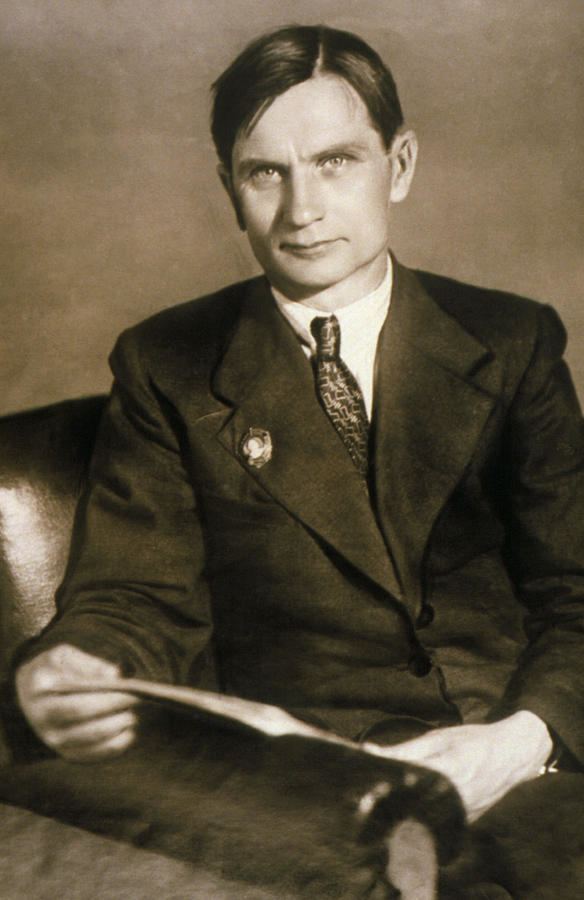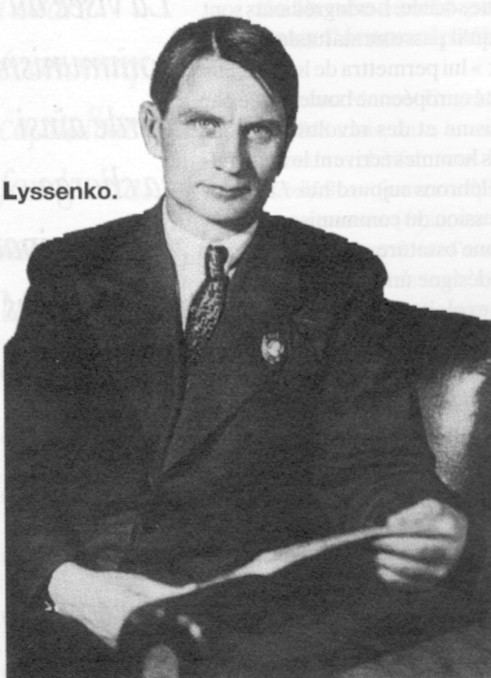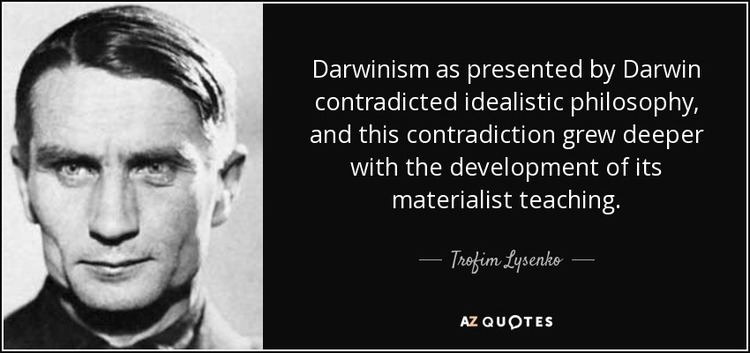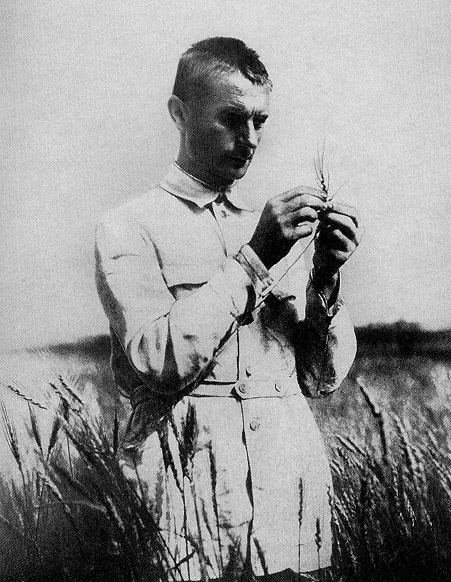Citizenship USSR Fields Biology, Agronomy Role Experimenter | Name Trofim Lysenko Nationality Ukrainian | |
 | ||
Born Institutions Russian Academy of Sciences Institution Russian Academy of Sciences Books Heredity and its variability, The Situation in Biological, Soil Nutrition of Plants, Agrobiology | ||
Trofim lysenko at the agricultural exhibit 1939
Trofim Denisovich Lysenko (Russian: Трофи́м Дени́сович Лысе́нко, Ukrainian: Трохи́м Дени́сович Лисе́нко; 29 September [O.S. 17 September] 1898 – 20 November 1976) was a Soviet agrobiologist. As a student Lysenko found himself interested in agriculture, where he worked on a few different projects, one involving the effects of temperature variation on the life-cycle of plants. This later led him to consider how he might use this work to convert winter wheat into spring wheat. He named the process "jarovization" in Russian, and later translated it as "vernalization". Lysenko was a strong proponent of soft inheritance and rejected Mendelian genetics in favor of pseudoscientific ideas termed Lysenkoism.
Contents
- Trofim lysenko at the agricultural exhibit 1939
- Trofim lysenko
- Early rise
- Work in agriculture
- Vernalization
- Lysenkos genetic theory
- Politics
- After Stalin
- Works
- References

His experimental research in improved crop yields earned him the support of the Soviet leader Joseph Stalin, especially following the famine and loss of productivity resulting from forced collectivization in several regions of the Soviet Union in the early 1930s. In 1940, Lysenko became director of the Institute of Genetics within the USSR's Academy of Sciences, and the exercise of political influence and power further secured his anti-Mendelian doctrines in Soviet science and education. Scientific dissent from Lysenko's theories of environmentally acquired inheritance was formally outlawed in the Soviet Union in 1948.

Though Lysenko remained at his post in the Institute of Genetics until 1965, his influence on Soviet agricultural practice had declined by the 1950s.

Trofim lysenko
Early rise

The son of Denis and Oksana Lysenko, Trofim Lysenko was born into a peasant family in Karlivka, Poltava Governorate (in present-day Poltava Oblast, Ukraine) on 29 September 1898.
As a young man working at the Kiev Agricultural Institute (now the National University of Life and Environmental Sciences of Ukraine), Lysenko worked on converting winter wheat into spring wheat. The conversion of winter wheat into spring wheat was not a new discovery. Scientific experiments had been done by Nikolai Vavilov. It was Vavilov who initially supported Lysenko and encouraged him on his work. Lysenko had a difficult time trying to grow various crops (such as peas and wheat), through the harsh winters. However, when he announced success, he was praised in the Soviet newspaper Pravda for his claims to have discovered a method to fertilize fields without using fertilizers or minerals, and to have shown that a winter crop of peas could be grown in Azerbaijan, "turning the barren fields of the Transcaucasus green in winter, so that cattle will not perish from poor feeding, and the peasant Turk will live through the winter without trembling for tomorrow."
Lysenko argued that there is not only competition, but also mutual assistance among individuals within a species, and that mutual assistance also exists between different species.
According to Lysenko,
The organism and the conditions required for its life are an inseparable unity. Different living bodies require different environmental conditions for their development. By studying these requirements we come to know the qualitative features of the nature of organisms, the qualitative features of heredity. Heredity is the property of a living body to require definite conditions for its life and development and to respond in a definite way to various conditions.
Work in agriculture
As noted above, Lysenko worked with different wheat crops in trying to convert them to grow in different seasons. Other investigations Lysenko found himself curious with, was the effect of heat on plant growth. He believed that every plant needed a determinate amount of heat throughout its lifetime. He attempted to correlate the time and the amount of heat needed by a particular plant requires to go through various phases of development. To get his data he looked at the amount of growth, how many days went by, and the temperature on those days. In trying to determine the effects, he made a small statistical reasoning error. This is a general trend that can be seen throughout the majority of his works and his major "findings". He was confronted by Maksimov, who was an expert on thermal plant development. Lysenko did not take well to this or any criticism for that matter. After this encounter, Lysenko boldly claimed that mathematics had no place in biology.
Vernalization
In 1927, at 29 years of age, working at an agricultural experiment station in Azerbaijan, he embarked on the research that would lead to his 1928 paper on vernalization, which drew wide attention because of its potential practical implications for Soviet agriculture. Severe cold and lack of winter snow had destroyed many early winter-wheat seedlings. By treating wheat seeds with moisture as well as cold, Lysenko induced them to bear a crop when planted in spring. Lysenko coined the term "Jarovization" (яровизация) to describe this chilling process, which he used to make the seeds of winter cereals behave like spring cereals. (Because spring cereals are called Jarovoe in Russian – from jar meaning fire or the god of spring.) However, this method had already been known by farmers since the 1800s, and had recently been discussed in detail by Gustav Gassner in 1918. Lysenko himself translated Jarovization as "vernalization" (from the Latin vernum meaning Spring). Lysenko's claims for increased yields were based on plantings over a few hectares, and he believed that the vernalized transformation could be inherited, that the offspring of a vernalized plant would themselves possess the capabilities of the generation that preceded it—that it too would be able to withstand harsh winters or imperfect weather conditions.
Lysenko's genetic theory
Lysenko rejected Mendelian genetic inheritance theory in favor of his own logic. He believed Mendel's theory to be too reactionary or idealist. Lysenko's ideas were for the most part his own and not directly derived from any already established ideas such as Mendelian genetics theory, Lamarckism, or ideas from Darwin. He shaped his genetic concepts to support the simple practical purpose of breeding and improving wheat. His ideas were also shaped with the caution to disprove other claims made by his fellow geneticists at the time. His ideas and genetic claims later began to be termed "Lysenkoism". He claimed that his ideas were not associated with Lamarckism and that they were unique, but that is not entirely true. It is possible to see that there are similarities between the two ideas, such as a belief in the inheritance of acquired characteristics. Some of Lysenko's ideas can also seem to be vitalistic. For example, he claimed that plants are self-sacrificing − they do not die to a lack of sunlight or moisture, but instead die so that healthy ones may live, and when they die they deposit themselves over the growing roots to help the new generation survive.
Lysenko believed that in one generation of a hybridized crop, the desired individual could be selected, mated again, and continue to produce the same desired product, not worrying about separation/segregation in future breeds. For that to work, he had to assume that after a lifetime of developing (acquiring) the best set of traits to survive, those were passed down to the next generation. That assumption disregarded the potential for variation or mutation. Lysenko did not believe that genes or DNA existed, and only spoke about them to say that they did not exist. He instead believed that any body, once alive, obtained heredity. That meant that the entirety of the body was able to pass on the hereditary information of that organism, and was not dependent on a special element such as DNA or genes. That puzzled biologists at that time because it went against all established notions of heredity and inheritance. It also contradicted the Mendelian principles that most biologists had been using to base their ideas on. Most scientists believed that Lysenko's ideas were not credible, because they did not truly explain the mechanisms of inheritance. Many scientists and history of science writers believe that his beliefs are pseudo-scientific, and have little relationship to genetics.
Another of Lysenko's theories was that obtaining more milk from cows did not depend on their genetics, but on how they were treated. The better they were handled and taken care of, the more milk would be obtained. Given that belief, Lysenko and his followers were well known for taking very good care of their livestock. Lysenko claimed that the cuckoo was born when young birds such as warblers were fed hairy caterpillars by the parent (rather than host) birds. Lysenkoites also believed that fertilization was not random, but that there was specific selection of the best mate. For reasons like these, many people view Lysenkoism as pseudo-scientific.
After World War II ended, Lysenko took an interest in the works of Olga Lepeshinskaya, an older feldsher and biologist, who claimed to be able to create cells from egg yolk and non-cellular matter. Lepeshinskaya recognized common ground between her ideas and Lysenko's. By combining both of their ideas it was possible to proclaim that cells could grow from non-cellular material, and that the predicted ratios of Mendelian genetics and meiosis were incorrect, thus undermining the basis of modern cytology, as well as genetics.
Politics
In the Soviet Union during the early and mid twentieth century, the country was under a time of war and then reformation. Political oppression was present causing tension among the state but also promoting the flourishing of science. This was possible due to the flow of resources and demand for results. Working with various plants such as wheat and peas, Lysenko aimed to manipulate them to increase the production, quality, and quantity. However, Lysenko in particular more so impressed political officials with his success in motivating peasants to return to farming.
The Soviet's Collectivist reforms forced the confiscation of agricultural landholdings from peasant farmers and heavily damaged the country's overall food production, and the dispossessed peasant farmers posed new problems for the regime. Many had abandoned the farms altogether; many more waged resistance to collectivization by poor work quality and pilfering. The dislocated and disenchanted peasant farmers were a major political concern to the Soviet leadership. Lysenko emerged during this period by advocating radical but unproven agricultural methods, and also promising that the new methods provided wider opportunities for year-round work in agriculture. He proved himself very useful to the Soviet leadership by reengaging peasants to return to work, helping to secure from them a personal stake in the overall success of the Soviet revolutionary experiment.
Lysenko with his ideas of farming practices that would yield better crops, encouraged more farmers to return to working their lands. This also impressed Stalin and was what really caught his eye. Another reason Stalin took a liking to was because of his background. Lysenko had come from a poor family, and was working to make a name for himself. He was not born rich and had no entitlements. Stalin wanted to appear to the people as a big supporter of the proletariat. By the late 1920s, the Soviet political leaders had given their support to Lysenko. This support was a consequence, in part, of policies put in place by the Communist Party to rapidly promote members of the proletariat into leadership positions in agriculture, science and industry. Party officials were looking for promising candidates with backgrounds similar to Lysenko's: born of a peasant family, without formal academic training or affiliations to the academic community.
Due to close partnership between Stalin and Lysenko, Lysenko acquired an influence over genetics in the Soviet Union during the early and mid twentieth century. Lysenko eventually became the director of Genetics for the Academy of Sciences, which gave him even more control over genetics. He remained in the position for several years until some time after the fall of Stalin and later Nikita Khruschchev, when he was relieved of his duties.
Lysenkoism also played well into the Soviet theme occurring at that time, which was to "create the new Soviet man". The logic was that if people are able to inherit the acquired characteristics, it could be possible to create a better society. This lent hope to the revolutionary leaders of the Soviet union, in that peasants could be turned into exceptional citizens. This, however, was never one of Lysenko's intentions. He had never wanted to apply his techniques and principles onto humans, and was in fact strongly against it. He disagreed with the eugenics movement entirely.
When the political support finally ceased, Lysenkoism collapsed and became no more. Some of those who had supported him remained faithful and hid in silence, others dropped their previous notions in order to obtain jobs elsewhere and to potentially hold some influence in the science community. This meant that there were still Lysenkoites amongst and influencing the scientific community. They had not been dealt with as those who had stood against them had.
After Stalin
Following Stalin's death in 1953, Lysenko retained his position, with the support of the new leader Nikita Khrushchev. However, mainstream scientists re-emerged, and found new willingness within Soviet government leadership to tolerate criticism of Lysenko, the first opportunity since the late 1920s. In 1962, three of the most prominent Soviet physicists, Yakov Borisovich Zel'dovich, Vitaly Ginzburg, and Pyotr Kapitsa, presented a case against Lysenko, proclaiming his work as pseudoscience. They also denounced Lysenko's application of political power to silence opposition and eliminate his opponents within the scientific community. These denunciations occurred during a period of structural upheaval in Soviet government, during which the major institutions were purged of the strictly ideological and political machinations which had controlled the work of the Soviet Union's scientific community for several decades under Stalin.
In 1964, physicist Andrei Sakharov spoke out against Lysenko in the General Assembly of the Russian Academy of Sciences:
He is responsible for the shameful backwardness of Soviet biology and of genetics in particular, for the dissemination of pseudo-scientific views, for adventurism, for the degradation of learning, and for the defamation, firing, arrest, even death, of many genuine scientists.
The Soviet press was soon filled with anti-Lysenkoite articles and appeals for the restoration of scientific methods to all fields of biology and agricultural science. In 1965, Lysenko was removed from his post as director of the Institute of Genetics at the Academy of Sciences and restricted to an experimental farm in Moscow's Lenin Hills (the Institute itself was soon dissolved). After Khrushchev's dismissal in 1964, the president of the Academy of Sciences declared that Lysenko's immunity to criticism had officially ended. An expert commission was sent to investigate records kept at Lysenko's experimental farm. His secretive methods and ideas were revealed. A few months later, a devastating critique of Lysenko was made public. Consequently, Lysenko was immediately disgraced in the Soviet Union.
After Lysenko's monopoly on biology and agronomy had ended, it took many years for these sciences to recover in Russia. Lysenko died in Moscow in 1976, and was ultimately interred in the Kuntsevo Cemetery, although the Soviet government refused to announce Lysenko's death for two days after the event and gave his passing only a small note in Izvestia.
Works
Heredity and Its Variability (1945)
The Science of Biology Today (1948)
